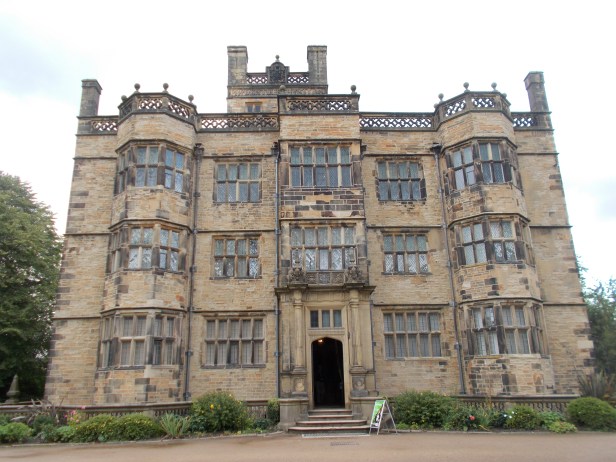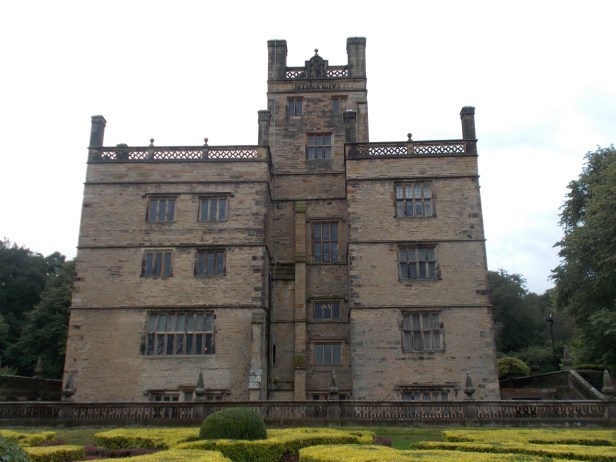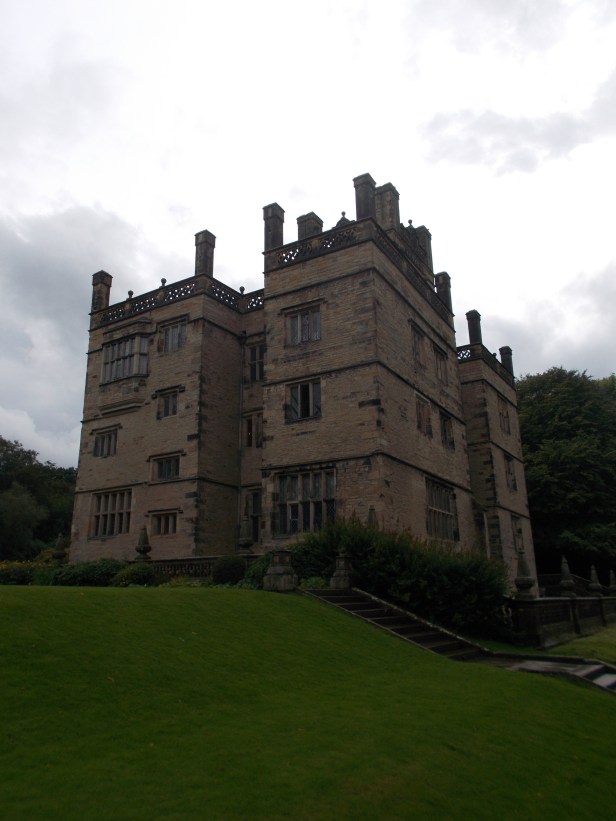Sir Richard Shuttleworth’s family had lived in the Gawthorpe area for over two hundred years. He made his fortune as a London lawyer and was wealthy enough to be asked to lend money to the crown (which was probably never returned). He also bought land at Forcett in North Yorkshire and Barbon in Westmorland, both of which his descendants would live at when they were not resident at Gawthorpe. Sir Richard married Margery, the widow of Robert Barton of Smithills, and he made Smithills Hall his home. However, when his wife died, in 1592, his right to stay at Smithills came to an end. It is probably soon after this that he began to plan for Gawthorpe Hall to be built. However, he died just three years later and his brother Reverend Lawrence Shuttleworth, a puritanical preacher, took over the construction.

The design for the house was done by noted architect Robert Smythson, who was also responsible for Hardwick Hall in Derbyshire. On the first day of construction all the workers were given a present of a pair of gloves. On “rearinge day” (the day the roof was put in place) a piper was paid to play in celebration. However, four more years were needed to construct the interior. All the ground room floors were wood panelled and noted artisans Francis and Thomas Gunby of West Yorkshire were commissioned to do the elaborate plaster ceilings in some of the more important rooms.
The huge aisled barn that still stands at Gawthorpe also dates from this time. It would have held both cattle and farm equipment, along with large amounts of animal feed.
Colonel Richard Shuttleworth
Reverend Lawrence Shuttleworth did not live long enough to actually move in to the house when it was completed. His nephew Richard Shuttleworth was the first resident, inheriting the hall in 1608.
Richard married Fleetwood Barton of Barton Lodge near Preston. He was a rare Lancashire patron of travelling groups of actors, musicians and circus performers. Performing troops from Lord Monteagle, Lord Stafford and Lord Dudley all visited Gawthorpe during his ownership.
As a very influential member of the area, he was High Sheriff of Lancashire twice and the MP for Preston. At the outbreak of the Civil War he was appointed a colonel for Parliament, commanding the army for the Blackburn Hundred area. His five sons also fought for Parliament and one of them, William, was killed on the attack on Lancaster Castle. Richard himself was wounded in action at Colne. Gawthorpe Hall was saved from the Royalists when Captain Ashton, commanding the colonel’s men, defeated them at the Battle of Whalley.
After the war, under Cromwell’s rule, Colonel Richard had a very active role in administering the local region. He worked as an ecclesiastical commissioner, a magistrate and remained a Member of Parliament. His duties involved confiscating land off former Royalist supporters, earning him the nickname “Old Smoot”. He also officiated over many marriages, both at the hall and in churches in the surrounding area, probably much to the displeasure of local clergy.

The Shuttleworths move away from Gawthorpe
At Colonel Richard’s death Gawthorpe was left to his grandson, another Richard. He had been brought up at Forcett in Yorkshire and the next generations would remain there, renting Gawthorpe Hall out to tenants.
The next Shuttleworth of note was Richard ‘Ready Money Dick’ Shuttleworth (1683—1749) who inherited Gawthorpe when he was just four years old. At 22 he was Tory MP for Lancashire and served in ten parliaments, becoming father of the house.
His son James was Tory MP for Preston and had a town house in the prestigious development of Winckley Square. Both the Shuttleworths continued to live at Forcett and let Gawthorpe out to Alexander Nowell and his son Ralph. The Nowells were both sympathisers to the 1745 Jacobite uprising, and coins (30 Portuguese gold and 52 English guineas) were hidden there during their time. The stash was discovered in the course of the Victorian restoration of the house. This has led some to speculate that, as it was never recovered, it had been hidden by the Jacobite-supporting Francis Townley of Towneley Hall (see more on his fate here). During the 1700s, the hall was becoming badly neglected and was used as a farm house. At one time the Drawing Room was used to store grain.
The Return to Gawthorpe
In 1816, Robert Shuttleworth returned to Gawthorpe to make it the family home once more, beginning a series of repairs to the property. He brought back the Shuttleworth portraits, plate and his valuable library. A barrister by training, his work as the chairman of the Quarter sessions at Preston led him to be known as the People’s Magistrate. Tragically he died within two years of his return, killed in a carriage accident. He left behind his wife Janet, and their young daughter also called Janet.
His daughter Janet was brought up in the south of England, but longed to return to live at Gawthorpe. In 1836, when she was not yet married, she wrote “it is not considered proprietous for a young lady to live alone in her house” but she would often visit the hall. Active in local education, she had the extension to Gawthorpe School built, which stood on the edge of her estate. In corresponding with the Board of Education she made the acquaintance of Dr James Phillips Kay, who was to become her husband. He is now recognised as the founder of free public education in Britain, for which he was made a baronet. They married in 1842 and he took the name Sir James Kay Shuttleworth.
He retired in 1848, due to ill health, and the next year he commissioned Sir Charles Barry to refurbish and upgrade Gawthorpe. Barry collaborated with A.W.N. Pugin and J.C. Crace, who also worked with him on the Houses of Parliament. Crace took many of Pugin’s designs and made furniture, curtains, carpets and wallpaper for the house.
Barry kept the restorations sympathetic to the original Elizabethan style. He raised the tower by a storey and erected parapets, along with the mottoes of the two families: Kind Friends Know and Keep, and Prudence and Justice.

During the restorations Charlotte Bronte visited Gawthorpe, which she described as “grey, castellated and stately”. During a holiday with the Kay Shuttleworths near Windermere they introduced Charlotte to the novelist Elizabeth Gaskell, who would become her biographer. Dr James was much impressed with Charlotte’s work, but we don’t know what she thought of the quality of his novels, which were written in local dialect.
Janet never saw Gawthorpe fully restored. Her marriage to Dr James deteriorated and from 1853 until the time of her death, some nineteen years later, she lived with her governess Miss Poplawska. The couple resided at health resorts in England, Germany and Italy.
Janet and James’s son Ughtred, Lord Shuttleworth, inherited Gawthorpe in 1872. He married Blanche Parish and they went on to have six children. Their sons Lawrence and Edward both died in the First World War. Lawrence’s sons Richard and Ronald (the 2nd and 3rd Lord Shuttleworths respectively) were both killed in the Second World War. Edward’s son Major Charles (4th Lord Shuttleworth) inherited Gawthorpe but the loss of a leg and paralysis from the war meant that he found the house unsuitable.
He moved to Leck Hall and his aunt Rachel Kay-Shuttleworth became the caretaker of Gawthorpe for much of her life. However, she also spent a lot of her time driving ‘hell for leather’ through the night in order to care for her father at Barbon, returning the next day to Gawthorpe to perform her supervisory role. Her vision was to make the hall a craft house with a focus on textiles and she accumulated an enormous and important collection. Shortly after her death Major Charles donated Gawthorpe to the National Trust. His son continued to live at Leck Hall and donated much of the original furniture that we see today in the house.

Gawthorpe Today
Gawthorpe is now jointly run by Lancashire County Council and the National Trust. It is a hugely popular tourist attraction, rightly recognised for its superb Tudor and Victorian features. Highlights include the Dining Room, Drawing Room and Long Gallery.
The Dining Hall (which was originally the Great Hall in the 1600s) has a minstrels gallery and entrance screen. Dating from 1605, this would have been used by performing actor troops in the staging of their plays. The Drawing Room features original Elizabethan plasterwork by Francis and Thomas Gunby, and Jacobean carved and inlaid panelling. The room also has Victorian furniture by Pugin and Crace. The Long Gallery, some 70 feet in length, again features a Gunby plaster work ceiling. Much of the rest of the room is Victorian and features a Pugin fireplace with William De Morgan tiles, and a recreated Pugin wallpaper.
Rachel Kay-Shuttleworth’s collection consists of 30,000 pieces of embroidery, lace and costume. It also contains important pieces from the Arts and Crafts embroidery movement. Dedicated rooms display some of the more interesting artefacts, as well as contemporary work.
Site visited by A. and S. Bowden 2019
Access
The hall is open late March through to early November, but check the website on the link below as times and dates vary. The gardens are open every day.
Gawthorpe Hall website is here
Nearby, a drive away
References
Gawthorpe Hall, Richard Dean (2018) National Trust. Available from Gawthorpe Hall
Backcloth to Gawthorpe, Michael P. Conroy (1996)
Mysteries and Memorabilia of Gawthorpe and the Shuttleworths, Michael P. Conroy (2003) Hudson History
Gawthorpe Remembered, Edited by John Rayment and Nick Dunnachie (1994) Lancashire County Council Museum Service
Comments are closed.